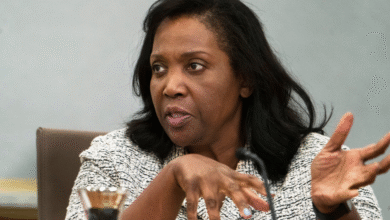Asana New CEO: Dan Rogers to Lead Company into AI Era

Asana’s leadership change marks a significant milestone with the appointment of Dan Rogers as the new CEO, following the retirement of co-founder and current CEO, Dustin Moskovitz. This transition, effective July 21, 2025, signals an exciting new chapter for the renowned collaboration software company. With Rogers’ impressive background leading organizations like LaunchDarkly and Rubrik, he brings valuable experience that will propel Asana into its next phase, particularly with an emphasis on AI integration in Asana’s products. Moskovitz, who co-founded Facebook’s parent company Meta, will continue to guide Asana as chair of the board, ensuring stability during this period of transformation. As the company braces for new opportunities, industry experts are keenly observing how Rogers will shape Asana’s future and embrace innovative technologies.
The recent shift in management at Asana introduces Dan Rogers, a seasoned executive with a rich history in tech leadership, as the new chief of operations. This pivotal transition follows the announcement of Dustin Moskovitz’s impending retirement from his role as CEO, a decision projected to enhance the company’s direction, especially in harnessing AI tools to optimize productivity. With Moskovitz retaining his position as board chair, the company is strategically positioned to navigate through this leadership change smoothly. Dan Rogers’ previous roles, including CEO at LaunchDarkly, will be crucial as he steers Asana towards a more technology-driven future. Stakeholders are eager to witness how this change will impact Asana’s market presence and its approach to integrating cutting-edge innovations.
Asana Leadership Change: Introduction of Dan Rogers as CEO
Asana has officially announced a significant leadership transition with the appointment of Dan Rogers as the new CEO. This comes after the notable decision by Dustin Moskovitz, the co-founder and current CEO, to step down and focus on his retirement, marking the end of an era for the software company. Dan Rogers, who is set to take charge on July 21, 2025, has an impressive track record, having held executive positions at major firms like Rubrik and ServiceNow. His experience positions him well to lead Asana into its next chapter, particularly as the company looks to innovate further in the realm of collaboration software.
Moskovitz’s retirement signifies a pivotal moment for Asana as it navigates the complexities of the tech landscape. Known for co-founding Meta, Moskovitz leaves behind a legacy of innovation and a strong brand identity for Asana. Under Rogers’ leadership, the company aims to embrace new challenges while maintaining its core mission of improving workflow and productivity for users. This seamless transition is crucial for company morale and stakeholder confidence, ensuring that Asana continues to thrive amidst a changing business environment.
Dustin Moskovitz’s Retirement and its Implications
Dustin Moskovitz’s decision to step down as CEO and transition to the board chair role presents significant implications for Asana and its employees. His leadership was marked by strategic decisions that propelled the company’s growth, particularly during the pandemic when remote collaboration tools became essential. Moskovitz’s commitment to fostering a workplace culture centered on productivity and collaboration will carry on, albeit under new leadership. His presence on the board will provide continuity and stability, allowing the company to maintain its vision while adapting to future challenges.
As Moskovitz retires, the focus will shift towards Dan Rogers and how he can build upon the foundation laid by his predecessor. With Rogers now at the helm, stakeholders will be eager to see how he plans to address ongoing market volatility and the integration of AI into Asana’s product offerings. This leadership change presents an opportunity for both innovation and revitalization within the company as it seeks to expand its footprint in the competitive software market.
AI Integration in Asana’s Future Strategy
The introduction of Dan Rogers as Asana’s new CEO coincides with a critical push towards artificial intelligence integration within the company’s offerings. Rogers brings a vision that includes leveraging AI tools to enhance productivity and streamline workflows. Asana has already made strides with its AI Studio software, reporting over $1 million in annualized revenue in its latest quarter. This focus on AI is seen as vital to keeping Asana competitive in a landscape where software solutions are increasingly driven by machine learning and automation.
AI integration is not merely an enhancement but a transformative strategy for Asana. As organizations evolve, the demand for intelligent solutions that can adapt to user needs grows. Under Rogers’ leadership, Asana aims to harness AI to revolutionize how teams collaborate and manage projects, highlighting a proactive approach to industry trends. This strategic direction could redefine workplace productivity, setting Asana apart in the crowded software marketplace.
Impact of Leadership Transition on Asana’s Stock Performance
Asana’s stock has seen a tumultuous journey since its public debut in 2020, peaking during the pandemic and subsequently dropping significantly. The leadership transition, with Dan Rogers stepping into the CEO role, is critical as investors assess how this change will impact the stock’s performance moving forward. The appointment comes at a time when the company is exploring new avenues for revenue generation and product innovation, particularly with AI enhancements. Investors will be keen to monitor how Rogers’ strategies will influence Asana’s market positioning and, consequently, its stock value.
The financial backdrop of this transition is equally noteworthy. With Moskovitz’s total compensation over five years recorded at a mere $5, and Rogers receiving a package worth potentially over $35 million, stakeholders are interested in how these financial dynamics will affect investor sentiment. Rogers’ substantial compensation reflects confidence in his leadership potential to steer Asana back on a growth trajectory, reclaiming its position in the market and enhancing shareholder value amid historical volatility.
LaunchDarkly’s Leadership Changes and Future Direction
In the wake of Dan Rogers taking the reins at Asana, significant changes are also underway at LaunchDarkly, the company from which he hails. The appointment of Marcus Holm as the new president signifies an internal shift aimed at sustaining growth and ensuring a seamless leadership transition. Co-founder Edith Harbaugh’s increased involvement in operations highlights the importance of strong leadership during uncertain times. As the tech landscape evolves, such leadership changes can significantly impact the direction and strategy of the company.
With Rogers now focusing on Asana, LaunchDarkly will need to find a new CEO who resonates with its mission and can navigate the challenges posed by market competition. The recent appointments emphasize the importance of continuity in leadership, especially as both companies seek to innovate and stay ahead in the rapidly advancing software sector. This interconnectedness of leadership adjustments across companies can create opportunities for collaborative innovation and shared growth.
The Role of Dan Rogers in Shaping Asana’s Culture
Dan Rogers’ transition into the CEO role at Asana heralds a new era for the company’s leadership culture. Known for his emphasis on collaboration and open communication, Rogers aims to foster an environment that encourages innovation and creativity among employees. This commitment to cultivating a supportive and collaborative culture is vital for retaining talent and driving productivity within Asana, especially as the company embarks on a path towards integrating advanced technologies like AI.
Rogers’ leadership style is expected to resonate well with Asana’s workforce, particularly as he values transparency and employee engagement. By prioritizing a culture that embraces change while maintaining connection, Rogers will be instrumental in aligning Asana’s operational goals with employee aspirations. This alignment is crucial, especially in a time of transition, where both leadership and employee morale can significantly affect overall company performance.
Strategic Vision for Asana with AI Tools
As Dan Rogers prepares to take charge as Asana’s new CEO, his strategic vision is centered around the integration of AI tools across various company products. This alignment with industry trends underscores the need for software solutions that not only enhance productivity but also create smarter workflows. Rogers aims to leverage AI to streamline operations and provide users with intuitive features that adapt to their needs, ensuring Asana remains at the forefront of the collaboration software market.
With AI’s potential to redefine how teams work, Rogers’ leadership is crucial in realizing this vision. By focusing on AI-enabled features, Asana can improve its value proposition, attracting new users while retaining existing ones. This approach could significantly elevate the user experience, enhancing collaboration and decision-making processes within teams. As the tech landscape continues to evolve, Rogers’ plan to integrate AI tools positions Asana as a trailblazer in the industry, capable of setting new standards in productivity software.
Looking Forward: Asana’s Roadmap Under Dan Rogers
As Asana moves forward with Dan Rogers as its CEO, the roadmap ahead appears promising yet filled with challenges. Rogers is expected to prioritize innovation while addressing the need for sustainable growth amid competitive pressures. His experience in steering previous companies towards success will be vital for Asana, particularly as it seeks to harness AI capabilities and refine product offerings. The roadmap will likely include a combination of strategic partnerships and continuous feedback from users to enhance the platform’s functionality.
Moreover, as Asana navigates through the transition period, employee engagement and stakeholder communication will play a critical role in its success. Rogers’ ability to articulate a clear vision for the future will be essential in rallying support and fostering a shared sense of purpose among the team. This collaborative approach will not only strengthen internal culture but also enhance Asana’s external brand reputation, setting the stage for a successful new chapter in the company’s history.
The Future of Asana: Innovations and Market Positioning
The future of Asana under Dan Rogers is poised for innovation and strategic market positioning, particularly in leveraging AI technologies. As the company seeks to redefine collaboration, Rogers’ leadership will be crucial in identifying and implementing advancements that cater to evolving user needs. The integration of AI within Asana’s products presents an opportunity to enhance user experience significantly and streamline work processes, ensuring the platform remains competitive in the fast-paced tech landscape.
Market positioning will also depend on Asana’s ability to differentiate itself through unique offerings and superior customer support. Under Rogers’ direction, the emphasis on innovation will likely attract new customers while retaining existing ones who value adaptability and efficiency in their collaboration tools. As Asana continues to evolve, its commitment to fostering innovation and responding to market demands will be pivotal in maintaining and enhancing its presence in the software industry.
Frequently Asked Questions
Who is the new CEO of Asana and what is his background?
Dan Rogers has been appointed as the new CEO of Asana, succeeding co-founder Dustin Moskovitz, who is stepping down. Rogers joins Asana from LaunchDarkly, where he served as CEO. He also has significant experience in leadership roles at Rubrik, ServiceNow, and Symantec.
What prompted the leadership change at Asana?
The leadership change at Asana was initiated by Dustin Moskovitz’s decision to retire as CEO. Moskovitz, known for co-founding Facebook’s parent company Meta, will remain on Asana’s board of directors as chair.
How will Dan Rogers influence the future of Asana?
Dan Rogers aims to guide Asana through its next phase by integrating advanced artificial intelligence tools into its products, leveraging his past experience in tech leadership to enhance the platform’s capabilities.
What is the significance of AI integration in Asana under Dan Rogers?
Under Dan Rogers’ leadership, Asana plans to focus heavily on AI integration, which Moskovitz believes will revolutionize work practices. This strategy could significantly enhance productivity and user engagement with Asana’s collaboration software.
What are Dan Rogers’ financial compensation details as Asana’s new CEO?
Asana’s new CEO, Dan Rogers, will receive a base salary of $650,000, $35 million in restricted stock units, and potential annual bonuses of up to $650,000.
How has Asana’s stock performed over the years, especially with the leadership change?
Since going public in 2020, Asana’s stock has been volatile, peaking at $142.68 in November 2021 and declining to $12.93 recently. With the appointment of Dan Rogers, the company hopes to implement new strategies that could positively impact its stock performance.
What roles were filled at LaunchDarkly due to Dan Rogers’ transition to Asana?
Following Dan Rogers’ appointment as Asana’s CEO, LaunchDarkly announced that Marcus Holm, the Chief Revenue Officer, will take over as president, while co-founder Edith Harbaugh will increase her involvement in operations as they search for a new CEO.
What is Dustin Moskovitz’s role after stepping down as Asana’s CEO?
After stepping down as CEO of Asana, Dustin Moskovitz will continue to serve as the chair of the board of directors, guiding the company in a different capacity while allowing Dan Rogers to take the lead.
| Key Points |
|---|
| Asana appoints Dan Rogers as new CEO effective July 21, 2025 following Dustin Moskovitz’s decision to step down. |
| Dustin Moskovitz will remain as chair of Asana’s board after retirement. |
| Dan Rogers previously held leadership roles at Rubrik, ServiceNow, and was CEO at LaunchDarkly since 2023. |
| Rogers will focus on integrating AI tools into Asana’s products to enhance collaboration. |
| Asana’s AI Studio generated over $1 million in annualized revenue last quarter. |
| Dan Rogers’ compensation includes a base salary of $650,000, $35 million in restricted stock units, and a performance bonus. |
| Asana’s stock price has dropped significantly since its peak in November 2021. |
| LaunchDarkly’s leadership transition includes Marcus Holm becoming president and co-founder Edith Harbaugh taking a more active role. |
Summary
Asana’s new CEO, Dan Rogers, marks a significant transformation for the company as it embraces the future of collaboration software. Under his leadership, Asana aims to leverage artificial intelligence to drive innovation and enhance productivity. This strategic focus is essential as the software industry evolves, particularly in response to changing work practices. With Rogers at the helm, Asana is poised to navigate its next chapter effectively, ensuring it remains a competitive player in the tech landscape.




